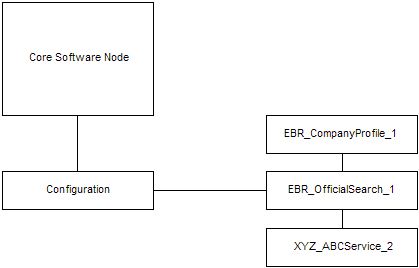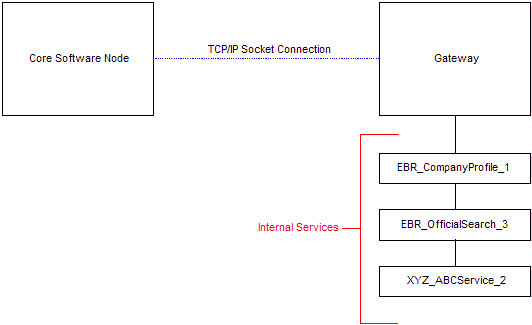|
|||||
|
| |||||
|
Table Of Contents
IntroductionAn EbrService is a component offered by an EbrNode that provides some valuable operation, e.g. it may offer a company report when given a company number, or produce an image of the company's latest set of accounts, or simply return a confirmation that the EbrNode is still active. Each EbrService has a unique EbrServiceId and performs a single defined operation, e.g. to return a Company Profile. The task of EbrDevelopers will be to implement the EbrServices permitted by their DataSource.
Developing Services
Character Set HandlingAll EbrMessages that handle XML EbrMessagePayloads must be encoded in the UTF-8 version of Unicode. This has obvious implications on any EbrServices you develop as each XML EbrService must be capable of handling UTF-8 encoded strings. Ideally, every EbrGateway and information source would already be UTF-8 enabled, but, of course, this is not always the case. Typically, your chosen programming environment and toolkits will hide the complexity of the character set conversion, but you should always be aware that the set of data your passing to your information source may contain special characters that your EbrGateway will not be expecting, for example, if your EbrGateway expects only standard ASCII strings, then you must first convert the UTF-8 data to ASCII, losing any special characters entered by the user, or reject the entire message by returning a code of -4 in X-Ebr-Service-Status. For more information about Unicode and UTF-8, the following links are recommended http://www.alanwood.net/unicode/Alan Wood's Unicode Resources http://www-106.ibm.com/developerworks/linux/library/l-linuni.htmlLinux Unicode Programming http://www.cl.cam.ac.uk/~mgk25/ucs/examples/UTF-8 Examples http://www.cl.cam.ac.uk/~mgk25/unicode.htmlUnix/Linux Unicode FAQ http://www.unicode.org/Unicode Home Page http://www.tldp.org/HOWTO/Unicode-HOWTO.htmlUnicode HOWTO
Content-Type: text/xml; charset="utf-8"
XML Namespace HandlingThe correct namespace for all EbrMessages that have XML EbrMessagePayloads must be of the following form: <CompanyProfileReply xmlns="http://ebr.orctel.com/ebr/xml/CompanyProfileReply"> ... ... </CompanyProfileReply> i.e. the last section of the namespace must match the root element name of the EbrMessage. The leading URL (http://ebr.orctel.com/ebr/xml/) must never be changed.
Wildcard SupportIf a field in a EbrMessage request contains an asterisk character (*) as the final character (right-most), that field should be interpreted as a wildcard and the appropriate search procedure created for your information source (if possible).
Handling Empty FieldsIf your EbrService
does not support an optional field in a reply, e.g.
Background: it is intended that fields not present in the reply will not be shown at the CommonUserInterface, i.e. the label for the field will not be displayed. Fields that are in the message but empty will will have the label displayed. However, if you typically support
<CompanyProfileReply> <!-- Mini example --> <CompanyName>Oracle</CompanyName> <CompanyNumber>Oracle</CompanyNumber> <FiscalCode/> <!-- Empty field --> </CompanyProfileReply> Note: if the value is a TableCode
then you can reference the
Handling Paged ResultsFor EbrServices
that return a list of results, e.g. In these cases the EbrGateway
should communicate such information via the attributes available
within the
Error HandlingIf you encounter a fatal error condition in the operation of your
EbrService
you must return the original EbrMessage
request that generated the error with one difference - you must
alter the
See also: EbrErrorScenarios
DeploymentEbrServices can be deployed either as dynamic extensions to an EbrNode (LocalService) or can alternatively be hosted within a privately developed custom server process (EbrGateway) for handling EbrService interactions (RemoteServices).
Local ServicesWhen an EbrNode
receives a message for itself (i.e. the
From config.xml: <ServiceList> <Service name="NetworkPoll" handler="com.orctel.ebr.service.NetworkPollService"/> <Service name="CompanySearch_1" handler="com.orctel.ebr.gateway.CompanySearchService"/> <Service name="OfficialProfile_1" handler="my.company.services.OfficialProfile"/> </ServiceList> If the Service is registered then the Node calls the (Java) class mapped to handle the EbrService.
Remote ServicesIf a request for NonRegisteredEbrService is received then the EbrNode forwards the exact message onto the configured "=GatewayNode=" server. The "=GatewayNode=" (EbrGateway) server gives EbrDevelopers the opportunity to access the exact same message received by the EbrNode they have installed by deploying a custom server to handle EbrMessages. The EbrGateway can be written in any language that can handle TCP/IP socket communication. Implementation details are left to the operator. An example EbrGateway and source code can be found as part of the Core Software distribution.
Because the EbrServices are separate from the Node itself, we term these RemoteServices.
Local Vs Remote ServicesThe choice of whether to use LocalServices or implement an EbrGateway to handle EbrServices outside of the CoreSoftware is left to the EbrDeveloper.
From here on this document focuses on developing local Java Services to be used within the distributed CoreSoftware but the same processing principles can still be applied to other languages.
|

